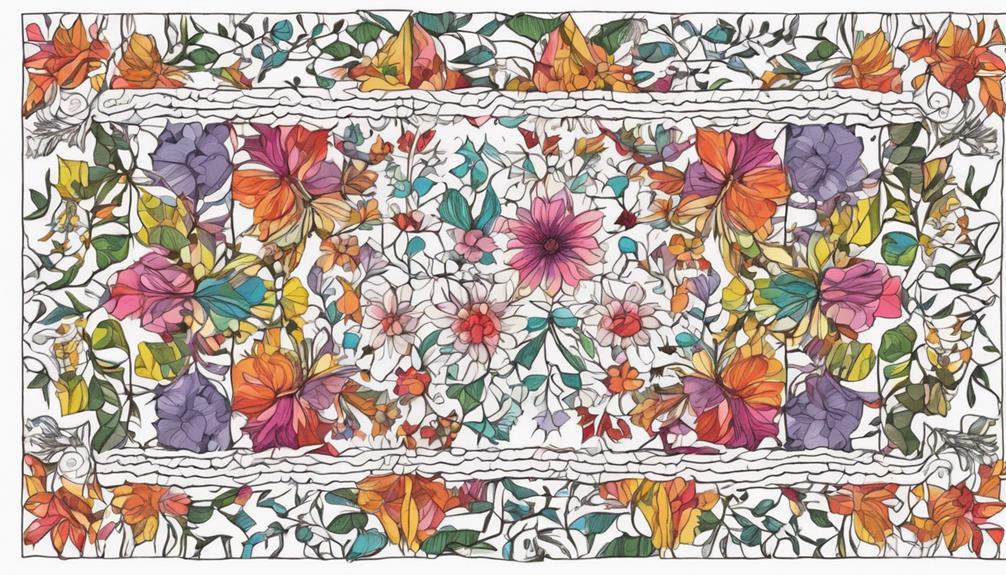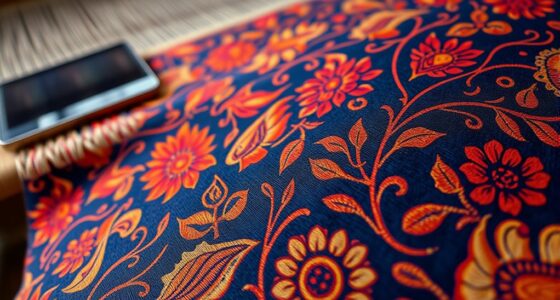Interactive textile art combines fabrics with embedded electronics to create garments and installations that respond to movement and light. By integrating conductive fabrics and sensors, you can make textiles that detect gestures, temperature, or pressure and trigger visual or lighting effects. This seamless blend of fashion and technology allows you to craft responsive, flexible pieces that transform traditional textiles into immersive sensory experiences. Keep exploring to discover more ways to enhance your designs with interactive elements.
Key Takeaways
- Conductive fabrics serve as flexible wiring, enabling seamless integration of sensors and electronic components into textiles.
- Embedded sensors detect gestures, pressure, or environmental changes, triggering movement or lighting effects in interactive textiles.
- Incorporating LEDs and actuators into fabrics allows garments to emit light or respond dynamically to user interactions.
- Sensor-electronic integration maintains fabric comfort while adding movement, light, and real-time responsiveness.
- Creative applications include wearable sculptures and responsive fashion that react visually and physically to user stimuli.

Have you ever wondered how textiles can engage your senses beyond just sight and touch? With the advent of interactive textile art, fabrics now have the potential to respond to your movements, gestures, and even environmental changes. This transformation is driven by sensor integration, which allows fabrics to detect stimuli and send signals to embedded electronics. Imagine wearing a piece of clothing that lights up or moves in response to your touch or body position. This is made possible through conductive fabrics—special textiles embedded with conductive fibers that act as wiring. These fabrics serve as the backbone for interactive elements, enabling sensors to be seamlessly integrated into the textile surface without sacrificing comfort or flexibility.
When you incorporate sensor integration into textiles, you embed sensors directly into the fabric in a way that they can detect pressure, stretch, proximity, or even temperature. These sensors are often made from conductive fabrics or coated with conductive materials, allowing them to pick up electrical signals generated by your movements. For example, a conductive fabric patch integrated into a jacket sleeve can register when you bend your arm or tap your hand, translating those gestures into digital signals. These signals then trigger responses like lighting up LEDs, activating motors for movement, or changing visual displays embedded within the textile. The key here is that conductive fabrics make it possible to embed these sensors seamlessly into the textile, maintaining the fabric’s softness and flexibility while adding electronic functionality.
This integration opens a world of possibilities for artists, designers, and tech enthusiasts. You can craft garments that interact dynamically with your environment, creating immersive, sensory experiences. For instance, a wearable sculpture that flashes colors when you move or a blanket that responds to your touch by emitting gentle vibrations. The beauty of using conductive fabrics is that they can be sewn, embroidered, or layered just like traditional textiles, but with the added power of electronics. This means you don’t need complex wiring or bulky components—just the conductive textiles and small, flexible sensors.
As you explore interactive textile art, you’ll find that sensor integration with conductive fabrics offers a flexible, durable way to add movement and light to your designs. You can craft responsive garments that sense your gestures and translate them into visual or kinetic responses. This fusion of textiles and electronics allows you to push creative boundaries, turning simple fabrics into dynamic, interactive art pieces. Whether for fashion, performance art, or personal expression, these technologies give you the tools to create textiles that don’t just look good—they respond, adapt, and engage in real time.
Frequently Asked Questions
What Are the Best Conductive Materials for Wearable Textile Electronics?
You should consider using conductive threads like silver-plated nylon or stainless steel for wearable textile electronics. These materials are flexible, durable, and easy to sew into fabrics. They work well with flexible sensors, ensuring comfort and reliable conductivity. Additionally, carbon-based conductive inks and fibers can be good options for creating responsive, lightweight electronic textiles that move seamlessly with your garments.
How Do I Ensure Durability in Electronic Textile Art Pieces?
Think of your textile electronics as a delicate web that needs strong anchors. To make certain of durability, focus on fabric reinforcement around connection points and wear areas, preventing fraying and breakage. Use robust conductive threads and secure solder joints properly. Regularly test and reinforce connections as needed, keeping your artwork resilient against movement and stress. This approach guarantees your interactive piece remains vibrant and functional over time, like a well-tended garden.
What Power Sources Are Safest for Interactive Textile Projects?
You should prioritize safe battery choices for your textile projects by selecting low-voltage, rechargeable options like lithium-polymer or nickel-metal hydride batteries. Always guarantee proper insulation and secure connections to prevent short circuits. Using portable power sources with built-in protection circuits enhances battery safety and reduces risks. Keep batteries away from moisture, and follow manufacturer guidelines for charging and handling, so your interactive textile art remains safe and reliable during display and use.
How Can I Troubleshoot Common Electronic Failures in Textile Art?
When troubleshooting electronic failures in textile art, start by checking for faulty wiring, as loose or damaged connections often cause issues. Additionally, look for software glitches that might disrupt functionality; restarting your device or updating firmware can help. Make certain power sources are stable and connections are secure. If problems persist, isolate components step-by-step to identify the faulty part, and consult wiring diagrams or troubleshooting guides for specific devices.
Are There Eco-Friendly Options for Electronic Components in Textiles?
Think of your textile art as a garden where every element contributes to harmony. You can choose eco-friendly electronic components like sustainable materials and biodegradable options to nurture that harmony. These environmentally conscious choices reduce waste and impact, helping your artwork thrive sustainably. By selecting biodegradable LEDs or using recycled circuit boards, you turn your project into a symbol of care for the planet, blending innovation with nature’s resilience.
Conclusion
By integrating electronics into textile art, you transform static fabrics into dynamic canvases that breathe with movement and light. This fusion invites viewers to not just observe, but to experience and engage, blurring the line between art and technology. As you explore this innovative frontier, remember: you hold the power to turn simple threads into a symphony of interaction, proving that the true magic lies in your ability to weave technology seamlessly into the fabric of creativity.









